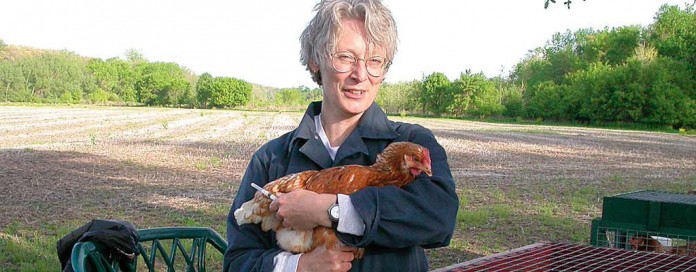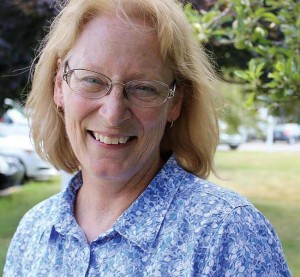
MEADVILLE, Pa. — She has told the story before. For a moment though, she’s caught off guard by a wash of emotions. She takes a deep breath, regains composure and delivers the last line, her voice cracking.
“The doctor said, ‘You just saved her mother’s life.'”
In context, the moment makes sense for Dr. Karen Martin, who stepped down from her post with the Pennsylvania Department of Agriculture last month after two decades working in the public sector. She was one of seven regional veterinarians in the state — her region covered Clarion, Crawford, Elk, Erie, Forrest, Jefferson, McKean, Mercer, Venango and Warren counties.
Another way to put it: “I’m your tax dollars at work.”
Finding answers

Back to the story. It isn’t new. But — in the midst of wrapping up a career she loved so she could focus on being near her parents — maybe the meaning of the story changed. Maybe it’s about the value of relationships and the importance of paying attention to details.
She always took time to present information about “zoonotic” diseases, those that affect both animals and humans. When the phone rang one day, she answered. It was a woman who attended one of Martin’s presentations. Martin had discussed Q fever, a bacterial infection that can be transmitted from animals to humans through birthing fluids, excrement and raw milk, in some cases, according to the U.S. National Library of Medicine.
The woman’s mother was sick, she thought it might be Q fever — the doctor wouldn’t test for it though because it wasn’t common. But her mother had the highest risk. She worked with sheep, she had delivered lambs bare-handed and she also had a heart valve defect. Martin connected the woman with the health department.
Emotion punctuates Martin’s words: The woman’s mother had Q fever.
“The doctor said, ‘You just saved her mother’s life.'”
For the people
Or maybe the story is about something simpler.
Martin believes those in her field should start with one task: When the phone rings, they answer — and they listen.
“We’re problem solvers,” she said. “We take on the problem, and we solve it, for the people.”
Did you catch the last part? Martin says it’s the foundation of her career, and it’s one piece of advice she has for the next generation of veterinarians tasked with representing the state and federal government.
“The most important thing I do is care about the people,” she said.
Changes
In late July, she sits in the Department of Agriculture building where she worked for 13 years.
During her veterinary career, which began in 1990, she watched her profession change with the evolving times, and she saw demands on animal and human disease professionals become more and more entwined. She and Dr. Enzo Campagnolo reminisced about the diseases they’ve dealt with over the years, rattling off a list: tuberculosis, pseudo rabies, brucellosis. Campagnolo is acting Pennsylvania public health veterinarian, and career epidemiology field officer for the Centers for Disease Control.
“A lot of the diseases that we used to work on, gone,” Martin said with a note of wonder. “So, we needed to shift a little and reach a wider audience.”
Enter emerging diseases. They may not be new, but they’ve evolved to the point that they’re impacting the population in different ways.
In the 1980s, avian influenza swept through Pennsylvania’s poultry population. The state lost 17 million birds worth $65 million, according to the Pennsylvania Department of Agriculture. The most recent strain has devastated poultry flocks in Midwestern states. Although the outbreak has stalled, states and federal agencies continue to monitor it, in case fall migration causes a greater spread. All the while, officials like Martin, Campagnolo and others have been working to prepare for an outbreak in their state.
“That network is in place, always practicing, getting ready,” Martin said.
Where the road leads
Before she was a veterinarian, she was an archeologist. A “roaming young woman,” she traveled to digs in England, Kentucky, Ohio and Texas.
“It was fun, living out of my pickup truck,” she said, pausing a moment to think about her life.
“Honest to God, I have had an awfully fun time.”
She still loves archeology — she’s the head of the Venango Archaeology Chapter. But calling? That was introduced early on by Dr. Paul Suorsa, a now-retired veterinarian in Slippery Rock, Pennsylvania.
Martin’s family raised beef cattle. As a child, Martin marveled at what would happen when a problem called for Suorsa’s expertise. The farm would be in an uproar, her father cursing, her mother crying. That’s when Suorsa’s shiny truck would barrel into the fray, flying up their long driveway.
“The veterinarian would get out his shiny bucket and put on his boots, and then he would fix everything,” she recalled. “Everyone would stop crying, they’d stop cursing. He was a wonderful man.”
Suorsa took Martin under his wing when she was a teenager, teaching her about ethics in the context of medicine. His influence stayed with her.
“It probably affected my entire career,” she said.
Side trip
She took a detour though. As a student at Grove City College in Grove City, Pennsylvania, a professor told her she needed perfect grades to get into veterinary medicine, and she didn’t have a 4.0 grade average. She took that to heart, graduated with a degree in history in 1977 and later began doctorate studies in anthropology at University of Pittsburgh. But it wasn’t her calling.
“Inside that career (in anthropology), I gravitated back to science,” she said.
When her Pitt adviser encouraged her to apply to veterinary school, she did. She graduated from University of Pennsylvania School of Veterinary Medicine in 1990. After spending a year working for the Department of Agriculture right out of vet school, she stayed. Her perspective? You can’t get away from calling.
“It doesn’t matter. If that’s what you really want to do, you won’t be able to get away from it,” she said. “It kept coming back to me.”
On call
Both Martin and Campagnolo are foreign animal disease diagnosticians. They’ve trained at Plum Island Animal Disease Center, a lab off the New York coast that conducts live testing on some of the world’s deadliest animal disease pathogens. Martin’s job was to connect farmers and their veterinarians with the right resources within the government when needed. Campagnolo’s job is to connect the agricultural side with the public health sector.
Dr. Holly Wise, an ambulatory equine veterinarian in the Greenville, Pennsylvania, area, said she counted on Martin for answers — especially as she was running from farm to farm during the day.
“That was one of the numbers you kept on hand,” she said. “I appreciated her very much.”
Big picture
The connection between animal and human disease was recognized as far back as the 1800s. The roles of people like Martin and Campagnolo are more connected than ever though. Private practice veterinarians tend to consider cases on an individual basis, while “we’re looking at population medicine,” Campagnolo said. The big picture suits Martin.
“You’re looking at disease from a different perspective,” she said. “You’re looking from above to see patterns.”
Part of her job was to educate those she worked with, through technology and face-to-face time.
“One of the big accomplishments of my career was to improve communication in the agricultural community,” she said.
Dr. Bill Wise, who runs a clinic in Punxsutawney, Pennsylvania, worked with Martin in her various public roles for decades.
“She’s absolutely one of the best,” he said. “She was able to put common sense to the law.”
In 2005, she received the President’s Award from the state Veterinary Medical Association for her work, particularly in developing County Animal Response Teams in northwestern Pennsylvania, according to her college’s alumni magazine. She counts the creation of those teams, spurred by the crippling 2001 foot-and-mouth disease outbreak in the United Kingdom’s livestock industry, as an important achievement.
Behind the scenes
Any given day, Martin and Campagnolo estimate there are hundreds of people throughout Pennsylvania working in similar fields for the state, the U.S. Department of Agriculture and other federal agencies. People like those who do the day-to-day work at the Meadville office.
“There’s a network of people like us, like them, out there, doing all these things to keep your food safe and your world safe,” Martin said.
“It’s a completely under-appreciated network of people.”
It’s those experiences and relationships that will stay with Martin. She’s not done working though. She is filling in part-time at the Greenville Veterinary Clinic. But she has had time to go kayaking and go on trips with her archaeology group. She even bought a fishing license. She moved onto her grandparents’ farm, next to her parents in the Grove City, Pennsylvania, area.
“I’ll probably be farming a little on my own,” she said.
Martin said she doesn’t regret any of the twists or the turns in her winding career path.
“There was no question this was the right career for me.”










What an absolutely wonderful person!